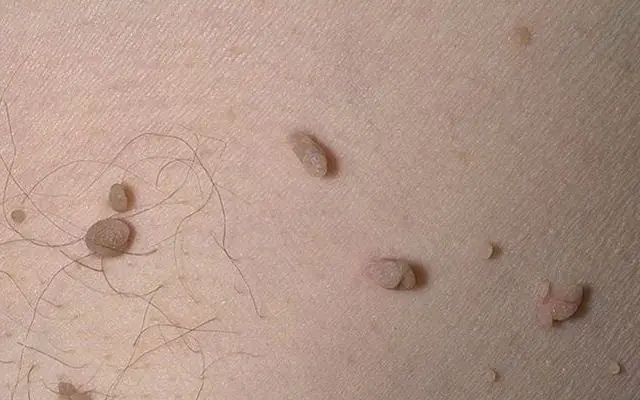
- Reasons for appearance
- Symptoms of filamentous papillomas
- Diagnostic methods
- Treatment methods
- Removal
- Medicines
- Folk remedies
- Prevention of filamentous papillomas
Filiform papillomas are elongated or rounded neoplasms on a thin stalk that can reach 5-6 mm in size. Usually affects the armpits, mammary glands, neck, and face. These are viral formations, and therefore they tend to spread to neighboring areas of the epidermis over time.
Causes of filamentous papillomas
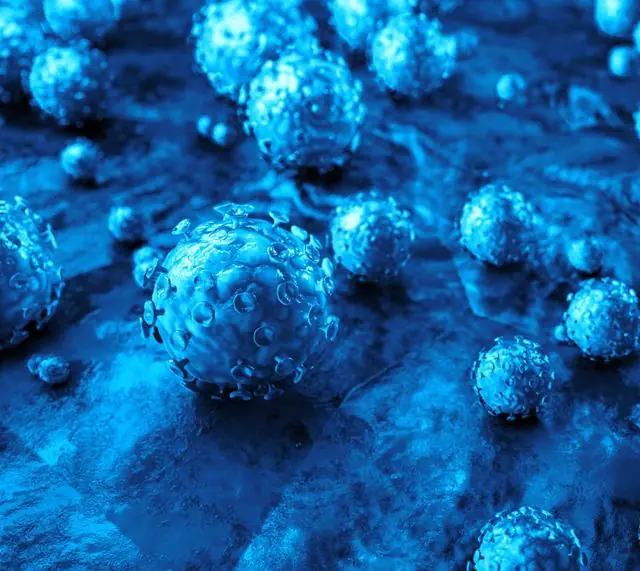
Papillomas of any type and size arise for only one reason - the activity of the human papillomavirus in the body. There are many types of this pathogen. Each strain is responsible for the development of various neoplasms. In particular, the formation of filamentous papillomas is caused by HPV types 3, 5, 8, 9. Otherwise, these neoplasms are called acrochords.
This viral agent penetrates the body through microdamage to the skin and mucous membranes. HPV is transmitted through sexual contact, household contact, and also from mother to child during childbirth. This pathogen is very contagious, that is, it is easy to “pick up” in a public place, through any contact with a carrier of the virus.
It should also be remembered that not everyone who has been infected with papillomavirus immediately develops filamentous papillomas on the body. It can take months or even years from infection to the formation of growths.
The likelihood of acrochord formation increases when certain factors confluence:
- General decrease in immunity for various reasons;
- Chronic fatigue, overwork, malnutrition, lack of sleep;
- Frequent hypothermia, colds;
- The presence of chronic diseases that reduce the body’s immune response - diabetes, thyroid pathologies, obesity and others;
- Promiscuous sexual intercourse, frequent change of intimate partners, early onset of sexual activity;
- Abuse of alcohol, cigarettes, drugs;
- Hormonal fluctuations - adolescence, menopause, pregnancy, abortion, miscarriage, ovarian dysfunction in women.
In the process of transmission of papillomavirus from an infected person to a healthy person, many other factors that contribute to infection also play a role. Thus, the virus penetrates the epidermis more easily if it is damp, excessively oily, and if there is excess moisture around the person.
In addition, filamentous papillomas more often affect mature and elderly people. After age 50, these growths occur in about half of patients with HPV. The older a person is, the higher the risk of developing acrochords. This type is practically never found in children and adolescents.
- Read about the features of preventing the appearance of warts
Symptoms of filamentous papillomas
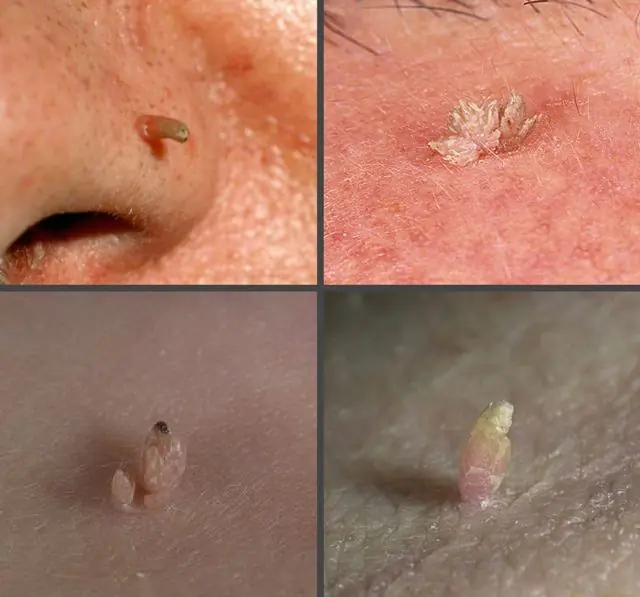
The photo shows filiform papillomas
Externally, thread-like papillomas are difficult to confuse with other types of benign growths. They look like thin threads from the epidermis, as well as small round or oval formations on a thin stalk.
Initially, these neoplasms have the appearance of yellowish nodules, which gradually stretch out and hang down on a stalk. Acrochords or thread-like papillomas have a loose but elastic structure, they are painless and do not cause itching, burning, or any discomfort. The usual length of the growth is 5-6 mm, but in rare cases it can be 1 cm.
Most often, filamentous papillomas form one at a time, but sometimes they can be grouped and appear as a cluster of growths in the form of broccoli or cockscomb. The shade of acrochords rarely differs from the body color. It may become a little darker over time - even brown.
As a rule, these growths affect areas of the body where friction is noted - the armpits, neck, woman's chest, groin area, but thread-like papillomas are often found in the mouth, on the face (eyelids, chin, lips, nose).
This type of neoplasm is caused by a non-oncogenic strain of HPV, and therefore they are not prone to malignancy and degeneration into cancerous tumors. However, due to the peculiarities of their localization, these growths are more often injured than others. Especially often injuries occur with thread-like papillomas under the tongue, on the neck, and face.
Acrochords can be rubbed by clothing, injured by hands, razor blades, toothbrushes, etc. Because of this, quite severe bleeding, inflammation, and suppuration can occur. In addition, in this way, HPV actively spreads to neighboring healthy areas of the body, and neoplasms will grow.Spontaneous recovery from filamentous papillomas is very rare. As a rule, these formations require medical diagnosis and subsequent therapy.
Methods for diagnosing filamentous papillomas

To make an accurate diagnosis, you will need a consultation with a specialist and a series of studies. On the Internet you can find photos of filamentous papillomas, but you should remember that at the initial stage of formation, these growths can be confused with other formations. Differential diagnosis is carried out to distinguish acrochords from the following benign rashes: chicken pox, pyoderma, molluscum contagiosum, genital condylomas, mole, pedunculated fibroma.
Initially, the specialist conducts a visual examination of the patient and assesses the number and size of growths. If necessary, a dermatoscope is used - a special microscope for examining the epidermis. It helps detect blood clots in blood vessels and signs of angiopathy.
Also, most likely, you will need to donate blood for tests. The presence of papillomavirus is confirmed by PCR analysis, as well as a number of other, more in-depth blood tests - for the concentration of the virus, its strain, oncogenicity, etc.
If all of the above methods for diagnosing filamentous papillomas turn out to be insufficiently informative, the doctor may prescribe a histological analysis or biopsy of the skin formation.
- Read also about the need to consult a virologist for papillomas
Methods for treating filamentous papillomas
Typically, acrochords or filamentous papillomas do not cause much discomfort to the patient. Therefore, people think about their treatment when there are many growths or they are located on noticeable areas of the body or face and represent a clear cosmetic defect. Treatment is most often complex and combines instrumental removal techniques, as well as medication.
Removal of filamentous papillomas
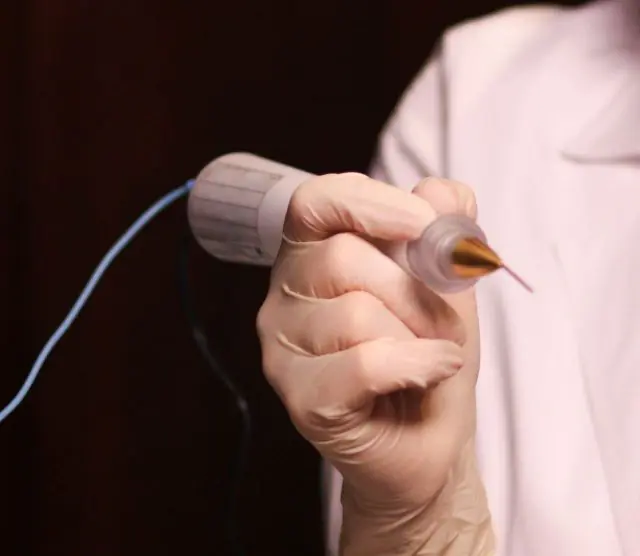
Physical destruction of neoplasms is the most effective way to get rid of this skin defect. Modern cosmetology offers several effective minimally invasive techniques, after which there are no marks left on the skin, and the regeneration process takes only a few days.
Let's look at the most popular and popular methods for removing filamentous papillomas:
- Laser destruction. This is one of the simplest and fastest methods for destroying benign tumors on the body. The laser beam is directed by a specialist to the growth, and the liquid is evaporated from the pathological cells. Thus, the filamentous papilloma literally dries out. The procedure is performed under local anesthesia. The operation lasts no more than a few minutes. As a result, a crust forms at the site of the neoplasm, which falls off along with the papilloma after a few days. The skin underneath remains clean and smooth. The cost of the procedure is 730-2100 rubles in Russia and 290-670 hryvnia in Ukraine.
- Radio wave removal. A special device is used that produces radio waves. The latter destroy the growth cells in much the same way as a laser beam, evaporating them. The operation is also performed under local anesthesia and leaves virtually no traces. Bleeding and relapses usually do not occur when using radio wave therapy. The price of the operation is 1750-2650 rubles in Russia and 460-1100 hryvnia in Ukraine. Read also about wound care after radio wave removal of papilloma.
- Liquid nitrogen removal. Otherwise, this operation is called cryoremoval, since the effect on neoplasms is carried out at low temperatures (approximately -195 degrees). Thus, thread-like papillomas on the body are literally frozen. This is an extremely simple procedure that is carried out in almost every cosmetology salon and clinic. It takes a minimum of time. But at the same time, it is important to control the depth of tissue damage so as not to affect healthy areas of the epidermis. The cost of removing filamentous papillomas with liquid nitrogen is 430-1000 rubles in Russia and 190-420 hryvnia in Ukraine.
- Electrocoagulation. A special electric knife is used to excise tumors. Essentially, the tissues of the growth are destroyed under the influence of current of special frequencies. This method is quite traumatic compared to those described above, since not only a wound, but also a burn remains at the site of exposure. They take longer to heal and may leave scars. On visible areas of the body, as well as to eliminate filamentous papillomas on the tongue, this method is rarely used. The price of electrocoagulation is 650-1100 rubles in Russia and 220-460 hryvnia in Ukraine. See also the results of electrocoagulation of papillomas.
- Surgical excision. A regular scalpel is used to remove growths. They cut off the acrochords. Scars may form at the site of removal. This method is considered quite outdated, and therefore is used less and less. The cost of surgical removal of papilloma is 500-800 rubles in Russia and 180-270 hryvnia in Ukraine.
Treatment of filamentous papillomas with medications
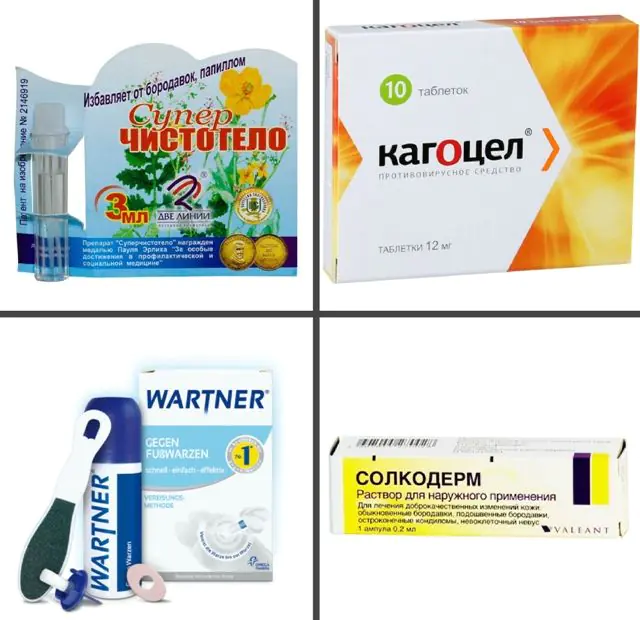
In the photo are preparations for filamentous papillomas
Drug treatment of skin growths can be carried out in different directions. Threaded papillomas can be cauterized with chemicals at home on the recommendation of a doctor, and courses aimed at suppressing the disease can also be taken.
It should be remembered that currently there is no medicine that can completely kill HPV in the blood. Therefore, the activity of all means is aimed only at suppressing the activity of the pathogen and transferring it to a passive state.
For the treatment of filamentous papillomas, the following groups of drugs are used:
- Chemical cauterizing drugs. These can be various alkaline or acidic solutions, ointments, creams. They act aggressively, destroying and necrotizing tumor tissue. They should be used with caution and only as prescribed by a doctor, so as not to provoke a severe burn, which will leave a scar or scar. This category of medicines includes: Salipod (from 75 rubles), Superchistotel (from 45 rubles), Solcoderm (from 450 rubles) and analogues - Collomak (from 400 rubles), Duofilm (from 1400 rubles), Ferezol (from 230 rubles) .
- Preparations with freezing effect. They operate on the principle of liquid nitrogen, but they are easy to use at home. Cellular connections are destroyed under the influence of low temperature. Pharmaceutical drugs from this group are suitable for self-medication: Wartner Cryo (from 2,700 rubles) and its analogue Cryopharm (from 850 rubles).
- Antiviral agents. To avoid relapses, especially in cases where there are a lot of filamentous papillomas on the body, the doctor may prescribe a course of antiviral drugs. These agents have an antiviral effect, preventing the infection from spreading and affecting new areas of the epidermis. Various ointments, creams, as well as tablets and injections can be used. Panavir (from 150 rubles), Viferon (from 200 rubles) and the analogue Isoprinosine (from 600 rubles) have proven themselves well in the treatment of HPV.
- Immunomodulatory drugs. Strong immunity suppresses viruses and prevents them from infecting skin cells. Therefore, immunomodulatory therapy is extremely useful in the treatment of acrochordas (filamentous papillomas). With well-developed protective functions of the body, the virus can be completely suppressed, and relapses will not occur. The following drugs are effective: Cycloferon (from 230 rubles), Imiquimod (from 3200 rubles) and the analog Kagocel (from 250 rubles).
Folk remedies for the treatment of filamentous papillomas

If there are few filamentous papillomas on the body, then you can try to get rid of them using traditional medicine recipes. However, such treatment can be fraught with complications - inflammatory processes, scars and scars on the skin. Therefore, consultation with a doctor is recommended before removing threadlike papillomas at home.
The following means are popular among the people:
- Garlic. It can be used fresh by squeezing the juice out of it, or by preparing a special ointment. We prepare the latter like this: chop a couple of cloves of garlic and mix with Vaseline. This ointment should be used to treat papillomas several times a day. You can also lubricate the growths with plant juice or apply cut slices as compresses. Garlic has an antiviral effect, and therefore suppresses HPV well.
- Celandine. One of the “classic” treatments for papillomas and warts among the people. It is necessary to cut off a mature plant and lubricate the new growth with the secreted juice. The procedure must be repeated several times a day until the growth completely dies off. Using the same scheme, you can treat papilloma with dandelion juice. See also ways to use celandine oil for papillomas.
- Rowan berries. This recipe is suitable for the winter treatment of filamentous papillomas, when celandine and dandelion are not available. You need to prepare a crushed pulp from ripe berries and apply it to the growths overnight as a compress. The manipulation must be carried out until the tumor disappears on its own.
These herbal medicine recipes are good when it is not possible to use another method of treatment, as well as when there are certain contraindications for taking pharmaceutical drugs, for example, during pregnancy or lactation. However, it should be remembered that the above plants are allergens, and if you suffer from intolerance to certain components, then be careful with them. If a reaction occurs in healthy areas of the skin, stop self-medication and consult a doctor.
- Read also: Is it possible to cauterize papilloma with brilliant green?
Prevention of filamentous papillomas

As a rule, filamentous papillomas on the neck and other parts of the body appear in older people who have reduced immunity. Therefore, the main way to prevent the formation of growths is to generally strengthen the body and strengthen its protective functions. This could include various hardening procedures, physical activity, adequate sleep and nutrition, giving up bad habits, and reducing stress in everyday life.
Regular intake of multivitamin complexes in winter and consumption of fresh fruits and vegetables in season also help well. In folk medicine and herbal medicine, there are also many recipes for immunomodulating decoctions and infusions that can boost immunity.
Compliance with personal hygiene rules reduces the risk of HPV infection, but it cannot completely protect a person from this infection, since it is very common. But a strong immune system all year round can suppress the virus so much that the patient may not even be aware of its existence in the body.
How to treat filamentous papillomas - watch the video:
[media=https://www.youtube.com/watch?v=wxiwfKqRMCg&t=26s]
Thread-like papillomas on the body appear, as a rule, in elderly people, as well as in patients with reduced immunity. It is practically very difficult to avoid the risk of HPV infection, however, competent treatment in combination with preventive measures can minimize the likelihood of the appearance of tumors on the skin.
- Related article: What types of papillomas are there on the body?



